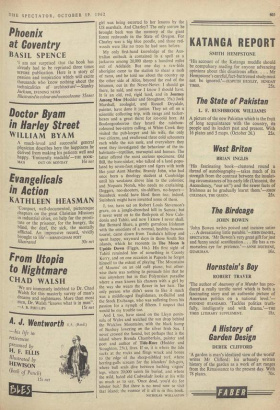In Continents and Islands
To touch the fringe of an unknown country, without the chance of penetrating it, is a tan- talising thing. Like an encounter with a stranger, those brief, guarded moments of curiosity offer a prospect of disappointment but also a promise of love, and it is little comfort to be told after- wards, by another traveller, just how much one missed.
John Steinbeck, of course, missed nothing. My experience of the United States is limited to a night at Miami airport, but now I know all I want to know about the rest. It is the grand country I always hoped it might be, and Travels With Charley (Heinemann, 2Is.) is a fine, generous, loving book. As Steinbeck himself says, 'there's absolutely nothing to take the place of a good man,' and for the author of a travel book I would add that there's absolutely nothing to take the place of a writer. A self-confessed bum in search of America, he drove a truck with a boat's cabin built on the back through forty States, and the only sorrow he brought back to his cottage on Long Island was the memory of the screaming white women outside a school in New Orleans where a little black
girl was being escorted to her lessons by the US marshals. And Charley? The only sorrow he brought back was the memory of the giant forest redwoods in the State of Oregon. For Charley was a big blue poodle, and those red- woods were like no trees he had seen before.
My only first-hand knowledge of the Aus- tralian outback is contained in a spell as a jackaroo among 20,000 sheep a hundred miles out of Adelaide. But one day a raw-hide aborigine came to the station to shear a mob of rams, and he told me about the country up the other side of Alice, beyond the end of the bitumen, out in the Never-Never. I should go there, he said, and now I know I should have. It is an old, red, rigid land, and in Journey Among Men (Hodder and Stoughton, 35s.) Jock Marshall, zoologist, and Russell Drysdale, painter, have done it justice. They set off on a scientific collecting trip, with swags and tucker- boxes and a great thirst for ice-cold beer. At Booloogoolooroo they heard the rainbow- coloured bee-eaters calling, at Whim Creek they visited the pub-keeper and his wife, the only two citizens, and swallowed three cold schooners each while the sun sank, and everywhere they went they investigated the behaviour of the in- habitants—reptilian, marsupial and human. The latter offered the most curious specimens: Old Bill, the bore-sinker, who talked of a land popu- lated by seven-foot niggers and tigers with teeth like your Aunt Martha; Brandy John, who had once been a theology student at Cambridge until his weakness drove him to the colonies; and Nopants Norah, who needs no explaining. Doggers, roo-shooters, sin-shifters, no-hopers- Steinbeck would have liked them too; indeed, Steinbeck might have invented some of them.
I, too, have sat on Robert Louis Stevenson's grave, on a jungle-drenched hill in Samoa; but I never went on to the flesh-pots of New Cale- donia and Tahiti, and now I know I never shall. But Bernard Share, a gently garrulous Irishman with the emotions of a normal, healthy-banana- tourist, came down from Tusitala's hilltop and spent happy, wayward days in those South Sea islands, which he recounts in The Moon Is Upside Down (Figgis, 16s.). His first sight of Tahiti reminded him of something in County Kerry, and on one occasion in Papeete he forgot himself to the extent of playing 'The Mountains of Mourne' on an old cafe piano; but other- wise there was nothing to persuade him that he was anywhere but in that Polynesian paradise where a man knows his chances with a girl by the way she wears the flower in her hair. The only person who didn't seem to like it much was a middle-aged Englishman, ex-Balliol and the Stock Exchange, who was suffering from his passion for a nymph of fifteen. I suspect that would be my trouble too.
And I, too, have stood on the Lleyn penin- sula of Wales and watched the sun drop behind the Wicklow Mountains, with the black hump of Bardsey lowering on the silver Irish Sea. I never crossed the Sound, but perhaps that is the island where Brenda Chamberlain, painter and poet and author of Tide-Race (Hodder and Stoughton, 25s.), lives. If so, it is where the tide sucks at the rocks and flings wrack and bones to the edge of the sheep-nibbled turf, where herring-gulls scream for the islanders' fish-guts, where bull seals dive between bathing virgins' legs, where 20,000 saints lie buried, and where the wild, hated old Cadwaladr looks at his wife as much as to say, 'Once dead, you'd do for lobster bait.' But there is no need now to visit that island; the essence of it all is in this book.
NICHOLAS WOLLASTON















































 Previous page
Previous page